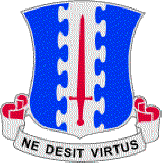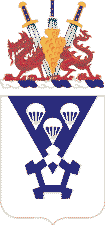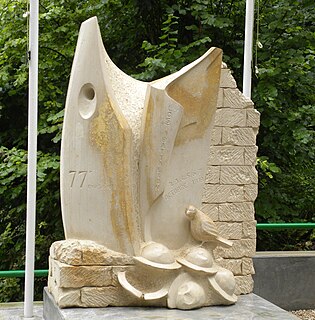 W
WThe 4th Battalion 17th Infantry Regiment is a United States Army infantry battalion. An earlier regiment designated the 17th Infantry Regiment was organized on January 11, 1812, but was consolidated with four other regiments as the 3rd Infantry in the post-war reorganization of the army following the War of 1812, due to the shattering losses it sustained at the River Raisin. The current battalion was constituted within the 17th Regiment of Infantry on May 3, 1861.
 W
WThe 100th Infantry Battalion is the only infantry unit in the United States Army Reserve. In World War II, the then-primarily Nisei battalion was composed largely of former members of the Hawaii Army National Guard. The 100th saw heavy combat during World War II, starting in September 1943 and continuing after being attached as a battalion of the Nisei 442nd Regimental Combat Team in June 1944. The unit was unofficially nicknamed the Purple Heart Battalion, with the motto "Remember Pearl Harbor" and "Go for Broke", which was later adopted by other Japanese-American units.
 W
W3rd Battalion, 153rd Infantry Regiment was a United States infantry battalion, headquartered at Warren, Arkansas, assigned to the 39th Infantry Brigade Combat Team of the Arkansas Army National Guard until it was deactivated on 5 September 2005. The history of the 3rd Battalion, 153rd Infantry as an individual battalion begins with the reorganization of the 39th Infantry Division in 1967 and the creation of the 39th Infantry Brigade (Separate). For history of the 3rd Battalion prior to 1967, see 153rd Infantry Regiment and 39th Infantry Division.
 W
WThe 3rd Battalion, 187th Infantry Regiment, also known as the Iron Rakkasans, is a battalion of the US Army 187th Infantry Regiment. The battalion was activated on 25 February 1943 and first saw action in the Pacific Theater of the Second World War, during the battle to regain US control of the Philippines. Troops from the battalion then served in the four-year occupation of Japan, where they earned their nickname "Rakkasans", before stationing in Fort Campbell, Kentucky. The battalion served in the Korean War from 1950 as the 187th Airborne Regimental Combat Team and participated in 12 major missions during the Vietnam War, emerging from that conflict as the US's most highly decorated airborne battalion. In 1992 they were designated as the "Iron" Rakkasans by Lieutenant Colonel David Petraeus due to his iron Rakkasan physical fitness test that added a fourth element of pull-ups to the standard APFT. The battalion has received numerous awards and commendations, including six Presidential Unit Citations and four Valorous Unit Awards.
 W
WThe 1st Battalion, 503rd Infantry Regiment is an active duty airborne infantry battalion in the United States Army, assigned to the 173rd Airborne Brigade Combat Team and stationed in Vicenza, Italy. The battalion has served with the 2nd Infantry Division, the 11th Airborne Division, the 24th Infantry Division, the 82nd Airborne Division, and the 173rd Airborne Brigade; has been stationed in Korea, Italy and the United States; and earned campaign credits in World War II, the Vietnam War, Operation Enduring Freedom-Afghanistan, and Operation Iraqi Freedom.
 W
WThe 2nd Battalion, 503rd Infantry Regiment is an active duty airborne infantry battalion in the United States Army, assigned to the 173rd Airborne Brigade Combat Team and stationed at Caserma Del Din, Vicenza, Italy. The battalion has served with the [2nd Infantry Division the rock |2nd Infantry Division], the 11th Airborne Division, the 24th Infantry Division, The 25th Infantry Division, the 82nd Airborne Division, the 101st Airborne Division, and the 173rd Airborne Brigade; has been stationed in Korea, Germany, Italy and the United States; and earned campaign credits in World War II, the Vietnam War, Operation Enduring Freedom-Afghanistan, and Operation Iraqi Freedom.
 W
WThe 551st Parachute Infantry Battalion was, for many years, a little-recognized airborne forces unit of the United States Army, raised during World War II, that fought in the Battle of the Bulge. Originally commissioned to take the French Caribbean island of Martinique, they were shipped instead to Western Europe. With an initial strength of 800 officers and enlisted men, the remaining 250 members of the Battalion were ordered on 7 January 1945 to attack the Belgian village of Rochelinval over open ground and without artillery support. During the successful assault the unit lost more than half its remaining men. The Battalion was inactivated on 27 January 1945 and the remaining 110 survivors were absorbed into the 82nd Airborne Division. Virtually nothing of the unit's history was known to the American public until the 1990s when renewed interest prompted its veterans to seek recognition for their costly success at Rochelinval. The battalion was awarded a Presidential Unit Citation in 2001 recognizing its accomplishment.
 W
WThe 555th Parachute Infantry Battalion, nicknamed The Triple Nickles, was an all-black airborne unit of the United States Army during World War II.
 W
W"The Lost Battalion" refers to the 1st Battalion, 141st Infantry, which was surrounded by German forces in the Vosges Mountains on 24 October 1944.
 W
WThe Lost Battalion is the name given to the nine companies of the 77th Division, roughly 554 men, isolated by German forces during World War I after an American attack in the Argonne Forest in October 1918. Roughly 197 were killed in action and approximately 150 missing or taken prisoner before the 194 remaining men were rescued. They were led by Major Charles W. Whittlesey. On 2 October, the 77th launched an attack into the Argonne, under the belief that French forces were supporting their left flank and two American units including the 92nd Infantry Division were supporting their right. Within the 77th sector some units including Whittlesey's 1-308th Infantry were making significant headway. Unknown to Whittlesey's unit, the units to their left and right had been stalled. Without this knowledge, the units that would become known as the Lost Battalion moved beyond the rest of the Allied line and found themselves surrounded by German forces. For the next six days, suffering heavy losses, the men of the Lost Battalion and the American units desperate to relieve them would fight an intense battle in the Argonne Forest.